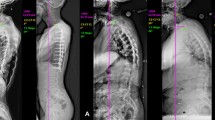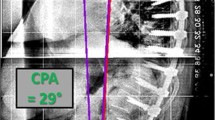Abstract
Background
Postoperative reciprocal changes (RC) in the cervical spine associated with varying factors of proximal junctional kyphosis (PJK) following fusions of the thoracopelvic spine are poorly understood.
Purpose
Explore reciprocal changes in the cervical spine associated with varying factors (severity, progression, patient age) of PJK in patients undergoing adult spinal deformity (ASD) correction.
Patients and methods
Retrospective review of a multicenter ASD database. Inclusion: ASD patients > 18 y/o, undergoing fusions from the thoracic spine (UIV: T6-T12) to the pelvis with two-year radiographic data. ASD was defined as: Coronal Cobb angle ≥ 20°, Sagittal Vertical Axis ≥ 5 cm, Pelvic Tilt ≥ 25°, and/or Thoracic Kyphosis ≥ 60°. PJK was defined as a ≥ 10° measure of the sagittal Cobb angle between the inferior endplate of the UIV and the superior endplate of the UIV + 2. Patients were grouped by mild (M; 10°–20°) and severe (S; > 20°) PJK at one year. Propensity Score Matching (PSM) controlled for CCI, age, PI and UIV. Unpaired and paired t test analyses determined difference between RC parameters and change between time points. Pearson bi-variate correlations analyzed associations between RC parameters (T4-T12, TS-CL, cSVA, C2-Slope, and T1-Slope) and PJK descriptors.
Results
284 ASD patients (UIV: T6: 1.1%; T7: 0.7%; T8: 4.6%; T9: 9.9%; T10: 58.8%; T11: 19.4%; T12: 5.6%) were studied. PJK analysis consisted of 182 patients (Mild = 91 and Severe = 91). Significant difference between M and S groups were observed in T4-T12 Δ1Y(− 16.8 v − 22.8, P = 0.001), TS-CLΔ1Y(− 0.6 v 2.8, P = 0.037), cSVAΔ1Y(− 1.8 v 1.9, P = 0.032), and C2 slopeΔ1Y(− 1.6 v 2.3, P = 0.022). By two years post-op, all changes in cervical alignment parameters were similar between mild and severe groups. Correlation between age and cSVAΔ1Y(R = 0.153, P = 0.034) was found. Incidence of severe PJK was found to correlate with TS-CLΔ1Y(R = 0.142, P = 0.049), cSVAΔ1Y(R = 0.171, P = 0.018), C2SΔ1Y(R = 0.148, P = 0.040), and T1SΔ2Y(R = 0.256, P = 0.003).
Conclusions
Compensation within the cervical spine differed between individuals with mild and severe PJK at one year postoperatively. However, similar levels of pathologic change in cervical alignment parameters were seen by two years, highlighting the progression of cervical compensation due to mild PJK over time. These findings provide greater evidence for the development of cervical deformity in individuals presenting with proximal junctional kyphosis.

Similar content being viewed by others
Data availability
Data is available upon request with appropriate access permissions.
References
Berthonnaud E, Dimnet J, Roussouly P, Labelle H (2005) Analysis of the sagittal balance of the spine and pelvis using shape and orientation parameters. J Spinal Disord Tech 18(1):40–47. https://doi.org/10.1097/01.bsd.0000117542.88865.77
Schwab FJ, Patel A, Ungar B, Farcy J-PP, Lafage V (2010) Adult spinal deformity-postoperative standing imbalance: how much can you tolerate? An overview of key parameters in assessing alignment and planning corrective surgery. Spine 35(25):2224–2231. https://doi.org/10.1097/BRS.0b013e3181ee6bd4
Vialle R, Levassor N, Rillardon L, Templier A, Skalli W, Guigui P (2005) Radiographic analysis of the sagittal alignment and balance of the spine in asymptomatic subjects. J Bone Joint Surg Am 87(2):260–267. https://doi.org/10.2106/JBJS.D.02043
Legaye J, Duval-Beaupère G, Hecquet J, Marty C (1998) Pelvic incidence: A fundamental pelvic parameter for three-dimensional regulation of spinal sagittal curves. Eur Spine J 7(2):99–103. https://doi.org/10.1007/s005860050038
Roussouly P, Gollogly S, Berthonnaud E, Dimnet J (2005) Classification of the normal variation in the sagittal alignment of the human lumbar spine and pelvis in the standing position. Spine 30(3):346–353
Lafage V, Schwab FJ, Vira S, Patel A, Ungar B, Farcy J-PP (2011) Spino-pelvic parameters after surgery can be predicted: a preliminary formula and validation of standing alignment. Spine 36(13):1037–1045. https://doi.org/10.1097/BRS.0b013e3181eb9469
Jang J-S, Lee S-H, Min J, Maeng DH (2007) Changes in sagittal alignment after restoration of lower lumbar lordosis in patients with degenerative flat back syndrome. J Neurosurg Spine 7(4):387–392. https://doi.org/10.3171/SPI-07/10/387
de Jonge T, Illés T, Bellyei A (2001) Surgical correction of Scheuermann’s kyphosis. Int Orthop 25(2):70–73. https://doi.org/10.1007/s002640100232
Klineberg E, Schwab FJ, Ames CP et al (2011) Acute reciprocal changes distant from the site of spinal osteotomies affect global postoperative alignment. Adv Orthop 2011:415946. https://doi.org/10.4061/2011/415946
Smith JS, Shaffrey CI, Lafage V et al (2012) Spontaneous improvement of cervical alignment after correction of global sagittal balance following pedicle subtraction osteotomy. J Neurosurg Spine 17(4):300–307. https://doi.org/10.3171/2012.6.SPINE1250
Oh T, Scheer JK, Eastlack R et al (2015) Cervical compensatory alignment changes following correction of adult thoracic deformity: a multicenter experience in 57 patients with a 2-year follow-up. J Neurosurg Spine 22(June):1–8. https://doi.org/10.3171/2014.10.SPINE14829
Lau D, Clark AJ, Scheer JK et al (2014) Proximal junctional kyphosis and failure after spinal deformity surgery: a systematic review of the literature as a background to classification development. Spine 39(25):2093–2102. https://doi.org/10.1097/BRS.0000000000000627
Glattes RC, Bridwell KH, Lenke LG, Kim YJ, Rinella A, Edwards C (2005) Proximal junctional kyphosis in adult spinal deformity following long instrumented posterior spinal fusion: incidence, outcomes, and risk factor analysis. Spine 30(14):1643–1649. https://doi.org/10.1097/01.brs.0000169451.76359.49
Lamartina C, Berjano P (2014) Classification of sagittal imbalance based on spinal alignment and compensatory mechanisms. Eur Spine J 23(6):1177–1189. https://doi.org/10.1007/s00586-014-3227-9
Passias PG, Horn SR, Frangella NJ et al (2018) Full-body analysis of adult spinal deformity patients’ age-adjusted alignment at 1 year. World Neurosurg 114:e775–e784. https://doi.org/10.1016/j.wneu.2018.03.079
Schwab FJ, Lafage V, Boyce R, Skalli W, Farcy J-PP (2006) Gravity line analysis in adult volunteers: age-related correlation with spinal parameters, pelvic parameters, and foot position. Spine 31(25):E959–E967. https://doi.org/10.1097/01.brs.0000248126.96737.0f
Rajnics P, Templier A, Skalli W, Lavaste F, Illés T (2002) The association of sagittal spinal and pelvic parameters in asymptomatic persons and patients with isthmic spondylolisthesis. J Spinal Disord Tech 15(1):24–30. https://doi.org/10.1097/00024720-200202000-00004
Bridwell KH, Lenke LG, Cho SK et al (2013) Proximal junctional kyphosis in primary adult deformity surgery: evaluation of 20 degrees as a critical angle. Neurosurgery 72(6):899–906. https://doi.org/10.1227/NEU.0b013e31828bacd8
Yagi M, King AB, Boachie-Adjei O (2012) Incidence, risk factors, and natural course of proximal junctional kyphosis: surgical outcomes review of adult idiopathic scoliosis. Minimum 5 years of follow-up. Spine 37(17):1479–1489. https://doi.org/10.1097/BRS.0b013e31824e4888
Kim YJ, Bridwell KH, Lenke LG et al (2008) Proximal junctional kyphosis in adult spinal deformity after segmental posterior spinal instrumentation and fusion: minimum five-year follow-up. Spine 33(20):2045–2050. https://doi.org/10.1097/BRS.0b013e31817c0428
Maruo K, Ha Y, Inoue S et al (2013) Predictive factors for proximal junctional kyphosis in long fusions to the sacrum in adult spinal deformity. Spine 38(23):E1469–E2146. https://doi.org/10.1097/BRS.0b013e3182a51d43
Kim HJ, Yagi M, Nyugen J, Cunningham ME, Boachie-Adjei O (2012) Combined anterior-posterior surgery is the most important risk factor for developing proximal junctional kyphosis in idiopathic scoliosis. Clin Orthop Relat Res 470(6):1633–1639. https://doi.org/10.1007/s11999-011-2179-1
Hart R, McCarthy I, O’brien M et al (2013) Identification of decision criteria for revision surgery among patients with proximal junctional failure after surgical treatment of spinal deformity. Spine 38(19):E1223–E1227. https://doi.org/10.1097/BRS.0b013e31829fedde
Yagi M, Akilah KB, Boachie-Adjei O (2011) Incidence, risk factors and classification of proximal junctional kyphosis: surgical outcomes review of adult idiopathic scoliosis. Spine 36(1):E60–E68. https://doi.org/10.1097/BRS.0b013e3181eeaee2
Kim HJ, Iyer S (2016) Proximal junctional kyphosis. J Am Acad Orthop Surg 24(5):318–326. https://doi.org/10.5435/JAAOS-D-14-00393
Yagi M, Rahm M, Gaines R et al (2014) Characterization and surgical outcomes of proximal junctional failure in surgically treated patients with adult spinal deformity. Spine 39(10):E607–E614. https://doi.org/10.1097/BRS.0000000000000266
Smith JS, Lafage V, Schwab FJ et al (2014) Prevalence and type of cervical deformity among 470 adults with throacolumbar deformity. Spine 39(17):E1001–E1009. https://doi.org/10.1097/BRS.0000000000000432
Passias PG, Soroceanu A, Smith J et al (2015) Postoperative cervical deformity in 215 thoracolumbar patients with adult spinal deformity: prevalence, risk factors, and impact on patient-reported outcome and satisfaction at 2-year follow-up. Spine 40(5):283–291. https://doi.org/10.1097/BRS.0000000000000746
Scheer JK, Tang JA, Smith JS et al (2013) Cervical spine alignment, sagittal deformity, and clinical implications. J Neurosurg Spine. https://doi.org/10.3171/2013.4.spine12838
Protopsaltis T, Terran J, Soroceanu A et al (2018) T1 slope minus cervical lordosis (TS-CL), the cervical answer to PI-LL, defines cervical sagittal deformity in patients undergoing thoracolumbar osteotomy. Int J Spine Surg 12(3):5042. https://doi.org/10.14444/5042
Protopsaltis T, Bronsard N, Soroceanu A et al (2016) Cervical sagittal deformity develops after PJK in adult thoracolumbar deformity correction: radiographic analysis utilizing a novel global sagittal angular parameter, the CTPA. Eur spine J Off Publ Eur Spine Soc Eur Spinal Deform Soc Eur Sect Cerv Spine Res Soc. https://doi.org/10.1007/s00586-016-4653-7
Diebo BG, Challier V, Henry JK et al (2016) Predicting cervical alignment required to maintain horizontal gaze based on global spinal alignment. Spine 41(23):1795–1800. https://doi.org/10.1097/BRS.0000000000001698
Lee S, Kim K-T, Seo E, Suk K, Kwack Y-H, Son E-S (2012) The influence of thoracic inlet alignment on the craniocervical sagittal balance in asymptomatic adults. J Spinal Disord Tech 25(2):E41–E47. https://doi.org/10.1097/BSD.0b013e3182396301
Kim T-H, Lee SY, Kim YC, Park MS, Kim SW (2013) T1 slope as a predictor of kyphotic alignment change after laminoplasty in patients with cervical myelopathy. Spine 38(16):E992–E997. https://doi.org/10.1097/BRS.0b013e3182972e1b
Weng C, Wang JJJC, Tuchman A et al (2016) Influence of T1 slope on the cervical sagittal balance in degenerative cervical spine. Spine 41(3):185–190. https://doi.org/10.1097/BRS.0000000000001353
Funding
The International Spine Study Group (ISSG) is funded through research grants from DePuy Synthes and individual donations and supported the current work.
Author information
Authors and Affiliations
Consortia
Contributions
Conception and design: PP, SN, TKW, RL, VL, FS, CS, JSS, MCG, EK,DCB, CA, SB; acquisition and data: SN, TKW, RL, FS, CS, JSS, MCG, EK,DCB, CA, SB; analysis and interpretation of data: PP, SN, TKW, RL, VL, JSS; approved the version to be published: PP, SN, TKW, RL, VL, FS, CS, JSS, MCG, EK,DCB, CA, SB; drafting of the manuscript: PP, SN, TKW; Critical revision of the manuscript for important intellectual content: PP, SN, TKW, RL, VL, FS, CS, JSS, MCG, EK,DCB, CA, SB; statistical analysis: PP, SN, TKW; obtaining funding: PP; administrative, technical or material support: none; agree to be accountable for all aspects of the work: PP, SN, TKW, RL, VL, FS, CS, JSS, MCG, EK,DCB, CA, SB; supervision: RL, VL, FS, CS, JSS, MCG, EK,DCB, CA, SB.
Corresponding author
Ethics declarations
Conflict of interest
Peter G Passias MD–Reports personal consulting fees for Spinewave, Zimmer Biomet, DePuy Synthes, and Medicrea outside the submitted work.
Additional information
Publisher's Note
Springer Nature remains neutral with regard to jurisdictional claims in published maps and institutional affiliations.
Rights and permissions
Springer Nature or its licensor (e.g. a society or other partner) holds exclusive rights to this article under a publishing agreement with the author(s) or other rightsholder(s); author self-archiving of the accepted manuscript version of this article is solely governed by the terms of such publishing agreement and applicable law.
About this article
Cite this article
Passias, P.G., Naessig, S., Williamson, T.K. et al. Compensation from mild and severe cases of early proximal junctional kyphosis may manifest as progressive cervical deformity at two year follow-up. Spine Deform 12, 221–229 (2024). https://doi.org/10.1007/s43390-023-00763-1
Received:
Accepted:
Published:
Issue Date:
DOI: https://doi.org/10.1007/s43390-023-00763-1




